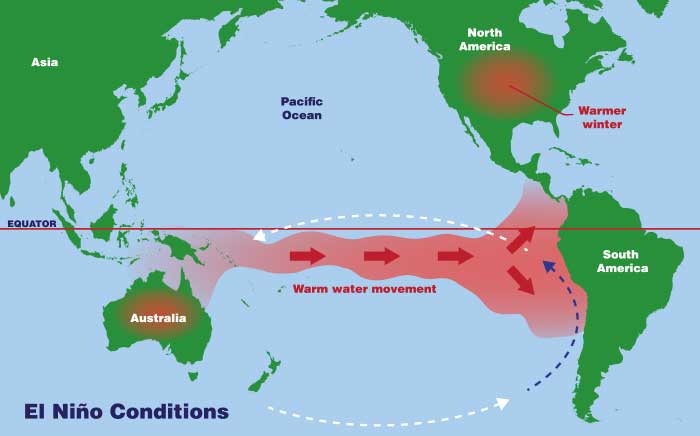
A New, Stronger El Nino Is Looming. Why Is That Important.
Scientists are predicting a strong El Nino phenomenon this year. Why is it important for us to know about it and what does that mean for climate patterns across the globe.
El Niño is a climate pattern that occurs irregularly in the Equatorial Pacific Ocean. According to National Geographic, El Niño is the “warm phase” of a larger phenomenon called the El Niño-Southern Oscillation (ENSO) (a grouping created by scientists due to the fact that the two oscillation patterns occur simultaneously), characterized by unusually warm water temperatures in the Equatorial Pacific. La Niña, on the other hand, is the “cool phase” of ENSO, and it describes the unusual cooling of the region’s surface waters.
What exactly happens during El Nino?
In normal weather conditions, the trade winds blow from east to west across the tropical Pacific, causing warm surface waters to accumulate in the western Pacific near Indonesia. This results in a thermocline, which is a distinct temperature difference between the warm surface water and cooler water below.
During El Nino, those normal conditions are reversed. The trade winds weaken or even reverse, allowing warm water to slosh back towards the central and eastern Pacific. This leads to a flattening or even a reversal of the thermocline, allowing warmer waters to spread eastward (photo below). In disrupting the usual upwelling of cold, nutrient-rich waters along the coasts of South America, El Nino can cause a decline in fish populations. It can also lead to coral bleaching in the Pacific due to increased ocean temperatures.
As the warm waters migrate eastward, they heat up the atmosphere above them. This alters the normal atmospheric circulation patterns, leading to changes in weather systems worldwide. The Walker Circulation, which is an east-west circulation pattern of the atmosphere, weakens or even reverses during El Niño events.
The altered atmospheric circulation affects precipitation patterns globally. For example, regions that typically experience wet conditions, such as parts of Indonesia and northern Australia, may become drier during El Niño. Conversely, regions that are usually dry, such as parts of South America, may experience increased rainfall.
El Niño events are also associated with a rise in global average temperatures. The redistribution of warm waters in the Pacific Ocean releases heat into the atmosphere, contributing to the overall warming trend. This effect can intensify the background warming caused by human-induced climate change.

El Nino and Global Warming
According to American climatologist, Michael E. Mann, carbon emissions are being absorbed by various reservoirs that exist within the global carbon cycle with only 55 percent of the emitted carbon showing up in the atmosphere. Of the remaining 45%, roughly 30 to 35 percent is believed to be absorbed by the Earth’s oceans, with another 15 to 20 percent going into the terrestrial biosphere.
As the oceans warm due to the increased rise in global average temperatures, the ocean CO2 solubility decreases, which means that the ability of oceanic water to absorb atmospheric carbon dioxide decreases over time (also referred to as the decreased uptake of carbon).
More El Nino like conditions in the future due to the increase in global temperatures could suppress the uptake of carbon by the oceans, increasing the CO2 levels in the atmosphere. Also, more mild La Nina conditions, which would see a reduced cooling of the surface water, could further accelerate the build-up of CO2 in the atmosphere. Given their irregular patterns and their unpredictability, scientists believe that El Nino and La Nina, given the accelerated global warming conditions, will likely decrease the uptake potential of the oceans over time, “yielding a positive net carbon cycle feedback” (a positive net carbon cycle feedback refers to a process or mechanism that amplifies the accumulation of carbon dioxide (CO2) in the atmosphere, thereby exacerbating climate change. While the term “positive” might sound beneficial, in this context, it signifies an increase in greenhouse gas emissions and the potential for more significant climate impacts).
Why can’t scientists still fully understand El Nino?
While scientists have made significant progress in understanding El Niño, there are several factors that contribute to the ongoing challenges in fully comprehending its intricacies and ultimate impact on climate variability.
- Complexity of Interactions: El Niño is influenced by various physical processes involving oceanic and atmospheric dynamics. These processes include ocean currents, temperature patterns, wind patterns, and interactions between the ocean and atmosphere. The interconnectedness of these factors makes it challenging to isolate and fully understand each component’s contribution to the phenomenon.
- Limited Data and Observations: El Niño events occur irregularly, with significant variations in intensity and duration. Obtaining comprehensive and long-term observational data to analyze and understand these events can be difficult. Historical records, satellite observations, and ocean buoys provide valuable data, but there are still limitations in the spatial and temporal coverage of these observations.
- Computational Challenges: Modeling and simulating the complex interactions that drive El Niño require sophisticated computational models. While significant advancements have been made in climate modeling, accurately capturing the intricate processes and feedback loops involved in El Niño remains a computational challenge. Improving the resolution and accuracy of these models is an ongoing endeavor.
- Climate Change Influence: El Niño patterns may be influenced by climate change, which adds another layer of complexity to the phenomenon. Understanding how climate change interacts with El Niño and potentially alters its characteristics requires ongoing research and analysis.
- Natural Variability: The Earth’s climate system exhibits inherent natural variability. This variability can sometimes mask or complicate the signals associated with El Niño. Differentiating between natural variability and El Niño-related signals is an ongoing challenge in scientific research.
Ed. Source of El Nino Conditions photo SciJinks.gov. Photo by Ruth Enyedi on Unsplash.
